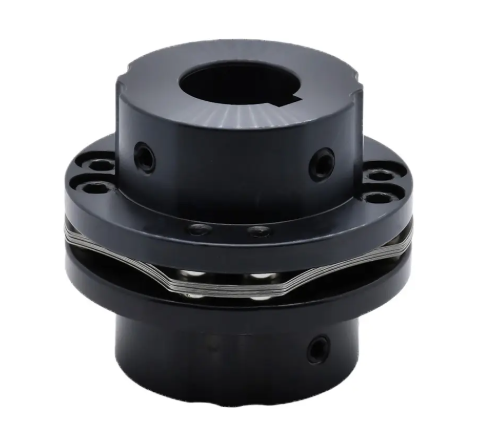Common Diaphragm Coupling Problems and Their Causes
Misalignment Issues
Misalignment is a prevalent issue in diaphragm Couplings and can be categorized into angular, parallel, and axial misalignments. Angular misalignment occurs when the shafts are angled relative to each other, while parallel misalignment involves the shafts being offset without an angle. Axial misalignment arises when there is a shift along the axis of the coupling. These misalignments lead to increased wear and tear on the coupling, reducing its efficiency and potentially causing system failure. According to industry studies, misalignment issues are a frequent problem in industrial applications, affecting the longevity and operational integrity of machinery. Regular checks and maintenance can help mitigate these problems and enhance the performance of equipment.
Excessive Vibration and Noise
Excessive vibration and noise in diaphragm couplings are primarily caused by imbalances and misalignments. These issues can have significant implications, including damage to adjacent equipment and increased operational costs due to frequent repairs. According to industry statistics, vibration-related failures account for a substantial portion of machinery malfunctions, highlighting the importance of addressing these concerns promptly. Reports from various sources indicate that managing these issues effectively can lead to a reduction in repair costs and extended equipment lifespan. Implementing regular maintenance schedules and employing advanced diagnostic tools can help in early detection and corrective actions.
Diaphragm Fatigue and Breakage
Diaphragm fatigue and breakage are critical concerns associated with diaphragm couplings. Fatigue refers to the wear and tear of diaphragm materials due to recurring operational stresses. Several factors contribute to this, including the quality of materials used and the intensity of operational loads. Signs of diaphragm breakage include unusual noise, vibration, or a decrease in coupling performance, which can severely impact equipment functionality. Manufacturers often provide data on the average lifecycle and fatigue limits of diaphragm couplings, with advanced materials like titanium alloys and stainless steel enhancing durability. Regular inspection and adherence to operational guidelines are crucial for preventing fatigue-related issues.
Corrosion and Material Degradation
Corrosion and material degradation in diaphragm couplings are typically caused by environmental factors and chemical exposure. Harsh conditions can lead to the breakdown of materials, affecting coupling performance and longevity. These issues can significantly reduce the lifespan of couplings, as evidenced by case studies on the impact of corrosive environments. To safeguard against material degradation, selecting diaphragm couplings made from corrosion-resistant materials and implementing preventive measures like coatings can be beneficial. Regular environmental assessments and maintenance routines can also help extend the operational life of diaphragm couplings and reduce potential downtime.
Diagnosing Diaphragm Coupling Failures
Visual Inspection Techniques
Visual inspection is a crucial method for diagnosing diaphragm coupling failures, allowing for quick detection of visible signs like wear and tear or structural damage. Regular visual checks can prevent more significant failures in systems relying on these couplings, maintaining operational efficiency. Industry best practices recommend frequent inspections, especially in environments prone to harsh conditions, to ensure problems are identified early. Implementing visual maintenance routines can save valuable time and resources by preemptively addressing issues before they escalate.
Vibration Analysis
Vibration analysis serves as an effective diagnostic tool for identifying problems in diaphragm couplings. By measuring key indicators such as frequency, amplitude, and vibration patterns, technicians can identify imbalances or misalignments affecting coupling performance. According to industry reports, vibration analysis significantly reduces downtime by accurately pinpointing issues without invasive procedures. Its efficacy in industrial settings ensures that equipment runs smoothly, minimizing vibration-related failures and optimizing performance.
Torque and Load Testing
Torque and load testing are fundamental in assessing the performance of diaphragm couplings, focusing on their ability to handle specified operational conditions. Under-torquing or over-torquing can lead to premature coupling failure, affecting overall system reliability. Therefore, understanding recommended torque specifications is essential, with different applications requiring tailored approaches. Following these specifications not only extends the lifespan of couplings but also enhances their effectiveness in transmitting power securely and efficiently across various industrial environments.
Step-by-Step Fixes for Diaphragm Coupling Issues
Correcting Shaft Misalignment
Correcting shaft misalignment is crucial for maintaining the efficiency and longevity of mechanical systems. Begin the correction process by using precision alignment tools such as laser alignment systems or dial indicators to measure misalignment accurately. Adjustments can then be made through carefully aligning the connected shafts within the coupling. Ensuring precise alignment minimizes energy loss, reduces vibrations, and extends the bearing and seal life of the machinery. Studies indicate that aligning shafts accurately can improve performance by up to 30%, significantly reducing energy consumption and operational costs.
Replacing Damaged Diaphragms
Replacing a damaged diaphragm involves a methodical approach to avoid further issues. Start by safely disconnecting power to the machinery and using appropriate tools like wrenches and torque drivers to disassemble the coupling. Carefully remove the damaged diaphragm and inspect surrounding components for wear. High-quality materials such as stainless steel or titanium alloys are recommended for replacements due to their excellent fatigue resistance and strength. As per industry experts, using quality materials significantly boosts system reliability, enhancing performance and safety. An appropriate diaphragm replacement not only restores function but also contributes to long-term operational stability.
Addressing Corrosion and Wear
Effective methods to combat corrosion and wear in diaphragm couplings include regular cleaning and application of protective coatings. Techniques like using non-abrasive cleaners to remove contaminants followed by applying anti-corrosion lubricants or epoxy coatings are highly effective. Consider using products that are market-proven for offering robust protection against environmental and operational wear. As reported by industry research, employing preventative maintenance solutions can extend diaphragm coupling life by as much as 50%, making it a cost-effective strategy. Additionally, addressing these issues can significantly reduce downtime and enhance equipment reliability, promoting sustained operational efficiency.
By following these step-by-step fixes, industries can enhance equipment longevity and performance, boosting overall productivity and reducing maintenance costs. Implementing these strategies not only rectifies existing problems but also safeguards against future diaphragm coupling failures.
Preventative Maintenance Strategies
Effective preventative maintenance strategies for diaphragm couplings not only enhance performance but also extend their lifespan. One crucial aspect of these strategies is Regular Alignment Checks. Routine alignment checks help prevent misalignment issues that could lead to severe system inefficiencies. Regular monitoring ensures each shaft is adequately aligned, maintaining balance in the coupling system and thus enhancing its operation. Methods for conducting these checks involve using laser alignment tools or dial indicators. Regular maintenance like this has been shown to dramatically cut costs associated with mechanical breakdowns and repairs, providing significant operational savings.
Lubrication is another key consideration in preventative maintenance strategies. Lubrication Best Practices are essential for keeping diaphragm couplings in optimal working condition. Proper lubrication reduces friction and wear, thereby extending the coupling's operational life. Manufacturers recommend specific lubrication schedules and types, often noting that synthetic lubricants offer the best performance. This correct application can lead to smoother operation, helping to prevent sudden equipment failures and ensuring consistent performance, as supported by data from various industry studies.
Lastly, maintaining diaphragm couplings involves Monitoring Operational Parameters regularly, which is vital for preventing failure. Critical parameters such as temperature and load fluctuations should be constantly tracked. Advanced software solutions and monitoring tools are available to offer real-time data and alerts on these parameters. Evidence from case studies suggests that this active monitoring can be highly effective in preemptively identifying issues and mitigating disruptions. By incorporating these monitoring technologies, operators can proactively manage their equipment, ensuring continued efficient operation and minimizing downtime.
FAQ
What is the primary cause of misalignment issues in diaphragm couplings?
Misalignment issues are caused by angular, parallel, and axial misalignments, often due to poor installation or operational conditions.
How can excessive vibration and noise be reduced in diaphragm couplings?
Reducing excessive vibration and noise involves addressing imbalances and misalignments, along with implementing regular maintenance schedules and diagnostic tools.
What materials can help prevent diaphragm fatigue and breakage?
Using high-quality materials like titanium alloys or stainless steel can prevent fatigue and breakage due to their excellent resistance to operational stresses.
How does corrosion affect diaphragm couplings, and how can it be prevented?
Corrosion degrades diaphragm materials, reducing lifespan. Prevention includes using corrosion-resistant materials and protective coatings.
What is the role of visual inspection in diagnosing diaphragm coupling failures?
Visual inspection helps quickly identify signs of wear or structural damage, allowing timely intervention to prevent system failures.
Table of Contents
- Common Diaphragm Coupling Problems and Their Causes
- Diagnosing Diaphragm Coupling Failures
- Step-by-Step Fixes for Diaphragm Coupling Issues
- Preventative Maintenance Strategies
-
FAQ
- What is the primary cause of misalignment issues in diaphragm couplings?
- How can excessive vibration and noise be reduced in diaphragm couplings?
- What materials can help prevent diaphragm fatigue and breakage?
- How does corrosion affect diaphragm couplings, and how can it be prevented?
- What is the role of visual inspection in diagnosing diaphragm coupling failures?

